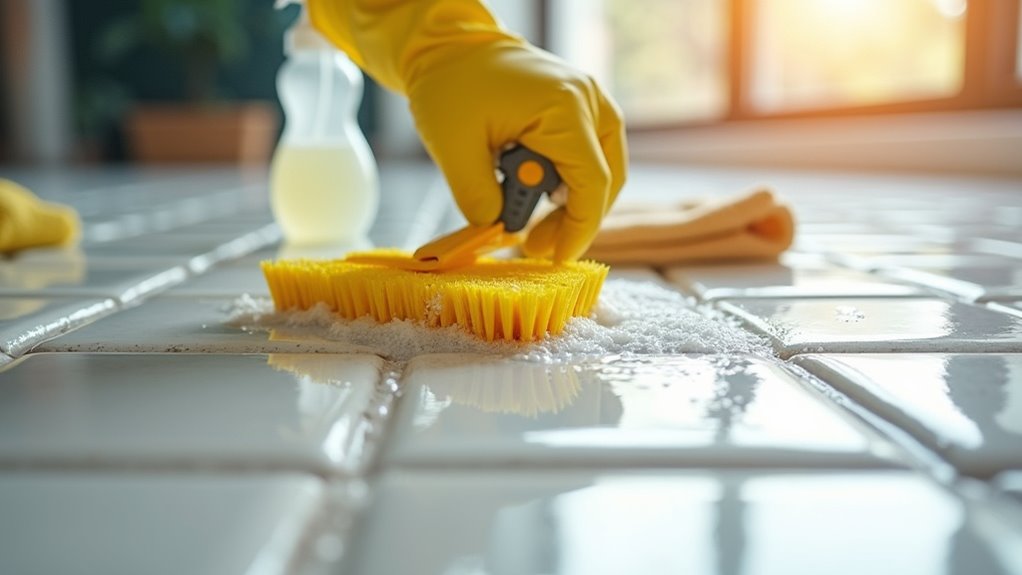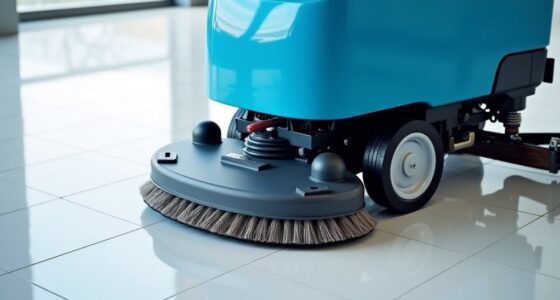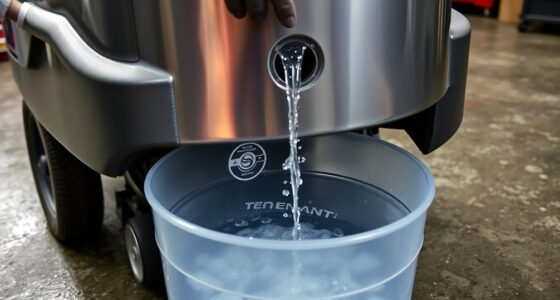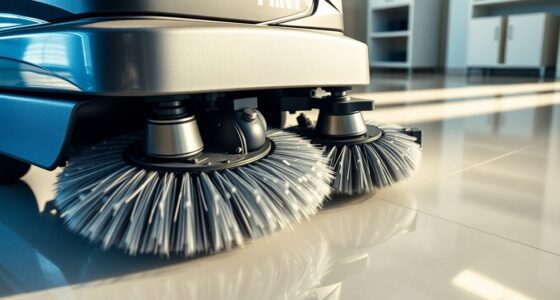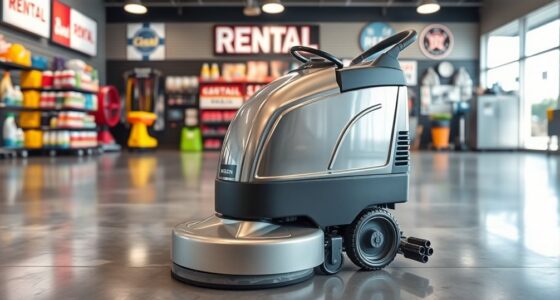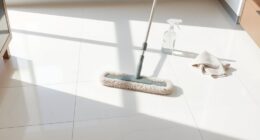To keep your tile floor scrubber in top shape, you should rinse brushes and squeegees daily, wipe down the exterior, and empty water tanks to prevent odors. Weekly, inspect and replace worn parts, check hoses and belts, and tighten fittings. Monthly, deep clean filters, examine batteries, and perform safety checks. Following this schedule helps maintain efficiency and extends your equipment’s lifespan—continue along to discover more essential tips for ideal upkeep.
Key Takeaways
- Rinse brushes and squeegees daily to remove debris and prevent buildup.
- Perform weekly inspections of hoses, belts, and worn parts; replace as needed.
- Clean filters and vents monthly to ensure proper airflow and prevent overheating.
- Check and tighten bolts, screws, and connections monthly for equipment integrity.
- Disconnect power before any maintenance, wear gloves, and follow safety guidelines consistently.
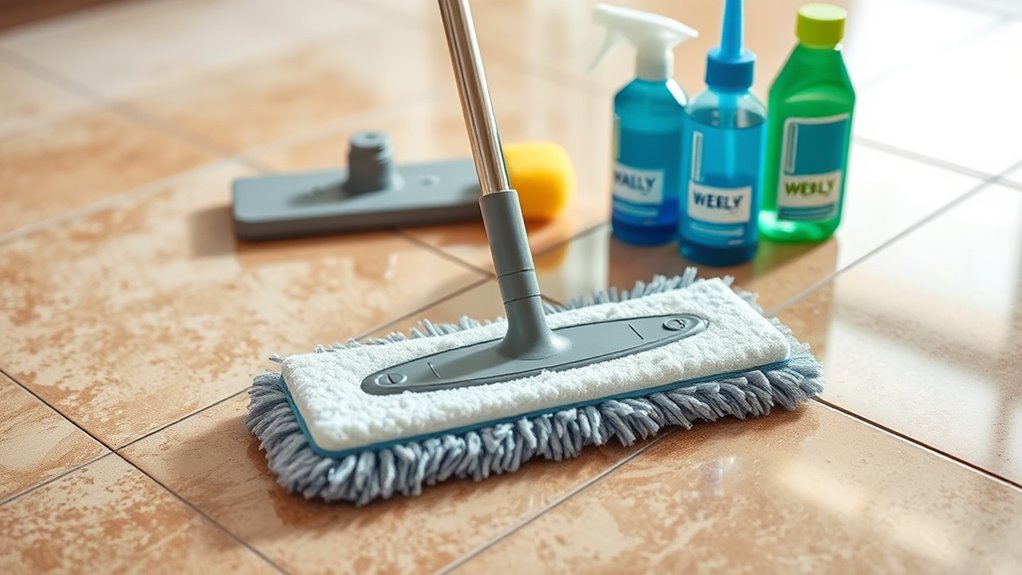
Maintaining your tile floor scrubber is essential for ensuring it works efficiently and lasts longer. Regular upkeep helps prevent breakdowns, keeps your cleaning consistent, and minimizes costly repairs. To do this effectively, you need to follow a structured care schedule that includes daily, weekly, and monthly tasks. The key is to pay attention to safety precautions and prioritize equipment maintenance to keep your scrubber in top condition.
Every day, after using your tile floor scrubber, you should rinse the brushes and squeegees thoroughly to remove dirt, debris, and any cleaning solution residue. This simple step prevents buildup that can impair performance. Always double-check that the water tanks are emptied and cleaned to avoid mold growth or unpleasant odors. Wipe down the exterior of the machine with a damp cloth to remove dust and grime accumulated during operation. During these daily routines, safety precautions are *crucial*—wear gloves when handling cleaning agents, and *ensure* the power is off before performing any maintenance. Keeping the equipment clean and dry reduces the risk of electrical issues and prolongs its lifespan. Regularly inspecting filter and vent components helps maintain optimal airflow and prevents overheating.
On a weekly basis, you should inspect and replace worn parts. Check the brushes and scrub pads for signs of wear; if they’re frayed or uneven, replace them to maintain effective cleaning. Examine hoses and belts for cracks or leaks, and tighten any loose fittings. Lubricate moving parts as recommended by the manufacturer to prevent rust and mechanical failure. Conduct a thorough check of the battery or power connections, *ensuring* they are secure and free of corrosion. Performing these maintenance tasks not only boosts performance but also enhances safety—faulty wiring or worn components can pose hazards if ignored. Regular equipment maintenance like this reduces the likelihood of breakdowns, saving you time and money in the long run.
Monthly, conduct a more *comprehensive* inspection of your tile floor scrubber. Deep clean filters and vents to *ensure* proper airflow and prevent overheating. Check the condition of the batteries, if applicable, and recharge or replace them as needed. Review the overall condition of the machine, looking for any signs of corrosion, rust, or damage. Tighten any loose bolts or screws to keep the machine sturdy and safe during operation. This in-depth maintenance helps you catch issues early before they become costly problems. Remember, following safety precautions during all maintenance routines is *vital*—disconnect the power source before working on electrical parts, and use appropriate tools to avoid injury. Regularly scheduled equipment maintenance like this not only extends your scrubber’s life but also guarantees it operates safely and efficiently, providing consistently clean floors with less downtime.
Frequently Asked Questions
Can I Use a Steam Cleaner on Tile Floors Regularly?
Yes, you can use a steam cleaner on tile floors regularly, but you should prioritize steam cleaner safety and tile floor maintenance. Make sure your steam cleaner has adjustable settings to prevent excessive moisture, which can damage grout or cause mold. Use it on a low or medium setting, and avoid leaving steam in one spot too long. Properly maintaining your tile floors guarantees they stay clean and in good condition over time.
What Type of Cleaning Solutions Are Safest for Glazed Tiles?
For glazed tiles, you want gentle cleaning solutions that are safe and effective. Opt for pH-balanced cleaners to avoid damaging the glaze or grout. Avoid harsh chemicals like bleach or ammonia, which can cause discoloration over time. Instead, use a mild, pH-balanced soap mixed with water or a specialized tile cleaner designed for glazed surfaces. This approach keeps your tiles clean without risking any damage or dullness.
How Do I Remove Stubborn Grout Stains Effectively?
Imagine you’ve got stubborn grout stains that just won’t budge. To tackle this, mix equal parts baking soda and water to form a paste, then apply it to the stained grout. Let it sit for 10-15 minutes, then scrub gently with a toothbrush. This stain removal method effectively lifts stubborn grout, making your tiles look clean again without harsh chemicals. Repeat if necessary for tough stains.
Is It Necessary to Seal Tiles After Scrubbing?
Yes, sealing tiles after scrubbing is necessary to guarantee proper tile protection. Applying a sealant creates a protective barrier that prevents stains, moisture, and grime from penetrating the tile and grout. This maintenance step helps preserve the appearance and durability of your tiles over time. Make sure to choose the right sealant for your specific tile type, and apply it evenly for maximum results in maintaining your floors’ longevity.
Can I Use a Scrubber on Delicate or Handmade Tiles?
You can use a scrubber on delicate surfaces like handmade textures, but you need to select the right one. Opt for a soft-bristled brush or a gentle pad to avoid scratching or damaging the delicate surface. Test the scrubber on a small, hidden area first to make sure it doesn’t harm the handmade textures. Always use mild cleaning solutions and avoid harsh chemicals to protect your delicate tiles.
Conclusion
Taking good care of your tile floor scrubber ensures it lasts longer and cleans more effectively. Did you know that regular maintenance can extend your scrubber’s lifespan by up to 30%? By following a simple daily, weekly, and monthly schedule, you keep your equipment in top shape and your floors sparkling. Stay consistent, and you’ll enjoy cleaner floors and a more efficient cleaning routine—making your home a healthier, happier space.
